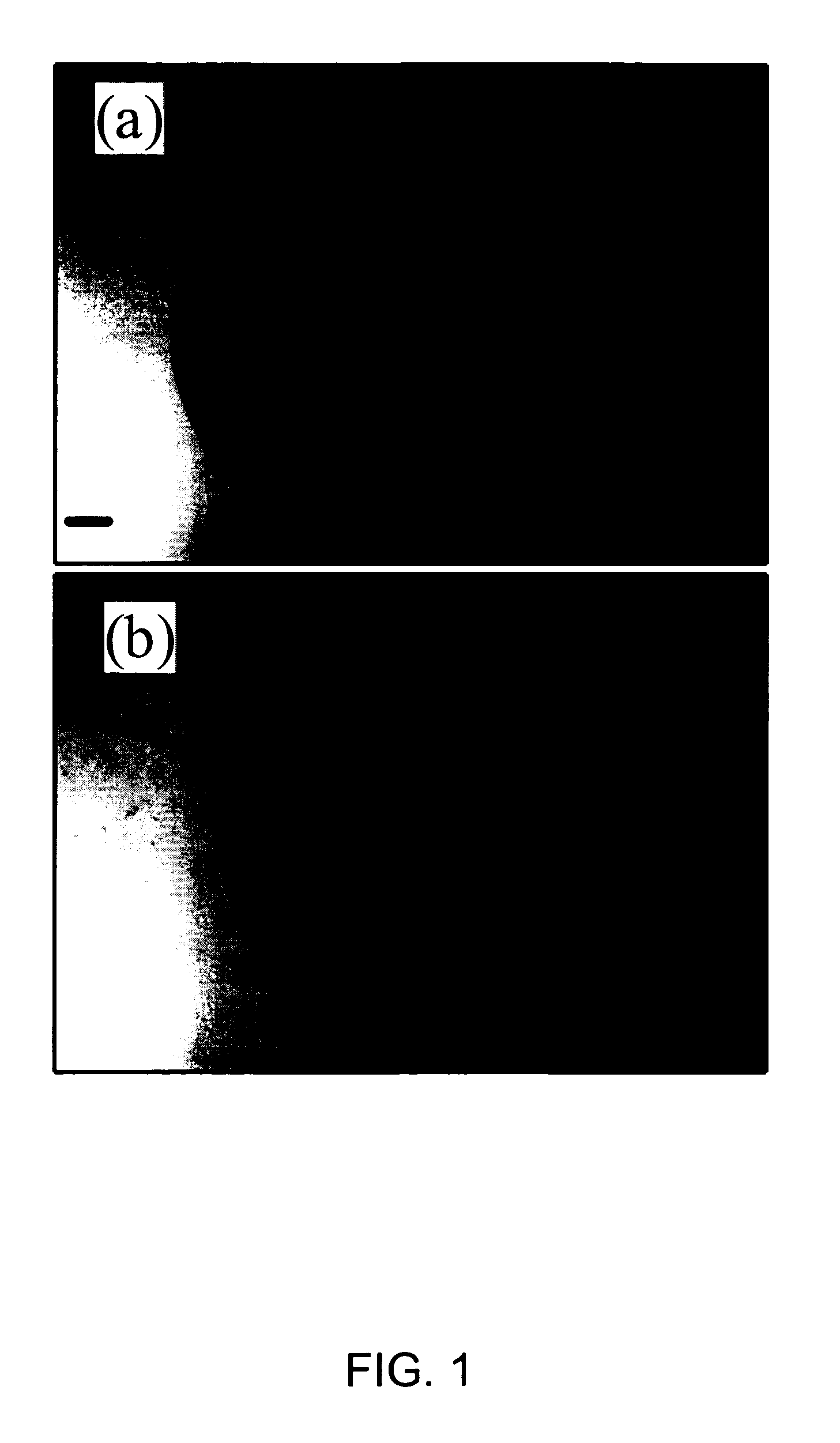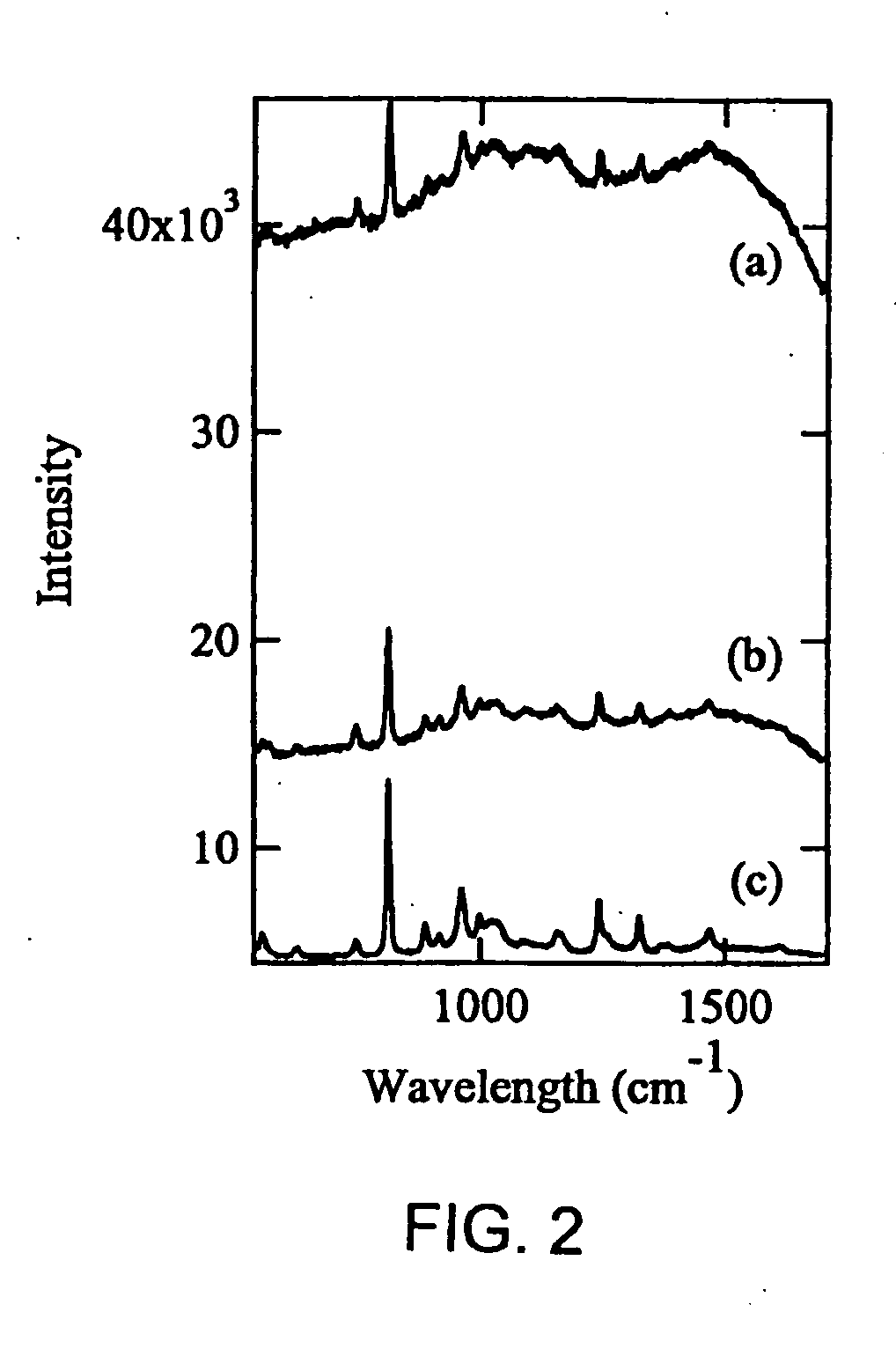Process and apparatus for segregation and testing by spectral analysis of solid deposits derived from liquid mixtures
a technology of liquid mixture and process, applied in the direction of spectrometry/spectrophotometry/monochromator, optical radiation measurement, instruments, etc., can solve the problems of raman scattering from biological compounds that are present at much lower concentrations, raman scattering from solvents containing buffering agents can overwhelm the normal raman scattering of biological compounds, etc., to achieve the effect of facilitating concentration or agglomeration, removing fluorescence effectively, and facilitating
- Summary
- Abstract
- Description
- Claims
- Application Information
AI Technical Summary
Benefits of technology
Problems solved by technology
Method used
Image
Examples
example set a
[0065] For the first example of the methods of the present invention that also demonstrates a significant reduction in undesirable fluorescence background, O-phospho-L-serine (Cat. No. P-0878, Lot 21K1389, Purity of 99%), myoglobin (Cat. No. M-0630, Lot 110K7034, Purity of 95-100%) and lysozyme (From chicken egg white) were obtained from Sigma. Synthetic human insulin (Humulin®) was provided by Eli Lilly & Co. High purity water (18.2 MΩcm−1) generated with MilliQ plus system (Millipore) was used to prepare a saturated O-phospho-L-serine (˜10 mM) and 60 μM myoglobin solution. 4 μL droplets of saturated O-phospho-L-serine and 60 μM myoglobin are deposited and dried on a substrate of polished stainless steel coated with 50 nm of PTFE. FIG. 1 shows the morphologies of the O-phospho-L-serine (a) and myoglobin (b) on the sample support after solvent evaporation. Both images are of the same size, the bar in image (a) represents 50 μm. Although the deposited volume is the same for both samp...
example set b
[0075] For this example demonstrating the high level of analyte discrimination that can be achieved using the methods of the present invention, four peptides were synthetically prepared that have the same amino acid sequence, and differ only in the site of phosphorylation. These four peptides have the same sequence found at the carbonyl terminus (residues 521-533) of the pp60c-src protein tyrosine kinase. When phosphorylated at Tyr-527, this fragment will suppress pp60c-src activity by binding, either inter- or intra-molecularly, to the SH2 domain of pp60c-src. The peptides used in this work were synthesized either in non-phosphorylated form, nP, or phosphorylated at one of three different residues, Ser-522, (sP), Thr-523, (tP), and Tyr-527, (yP), as described in Table 1, which also contains the abbreviated notations used in this example to designate each peptide.
TABLE 1Peptide sequence, phosphorylation site, and short-hand notation.Peptide sequenceNotationH2N-Thr-Ser-Thr-Glu-Pro-...
example set c
[0080] The present example set demonstrates that the present invention can be used to detect and quantify Tyr phosphorylation in tryptic digests of physiologically important proteins. While the peptides used in this example set are produced synthetically, three of them have the same sequence as peptides obtained by tryptic digest of p60c-src, with phosphorylation sites at Y-216, Y-419 and Y-530, respectively, as shown in the sequence in FIG. 11A. The fourth peptide is a shorter variant of the above Y-530 containing peptide. The peptides have varying lengths of between 11 and 32 residues and some contain both Tyr and Phe aromatic residues while others contain multiple Tyr residues. Although the four peptides have quite different Raman spectra, tyrosine phosphorylation induces similar spectral changes in all of the peptides. Furthermore, the present example shows that with the help of a partial least squares PLS multivariate calibration algorithm, the present invention can be used to ...
PUM
| Property | Measurement | Unit |
|---|---|---|
| thickness | aaaaa | aaaaa |
| thickness | aaaaa | aaaaa |
| volume | aaaaa | aaaaa |
Abstract
Description
Claims
Application Information
 Login to View More
Login to View More - R&D
- Intellectual Property
- Life Sciences
- Materials
- Tech Scout
- Unparalleled Data Quality
- Higher Quality Content
- 60% Fewer Hallucinations
Browse by: Latest US Patents, China's latest patents, Technical Efficacy Thesaurus, Application Domain, Technology Topic, Popular Technical Reports.
© 2025 PatSnap. All rights reserved.Legal|Privacy policy|Modern Slavery Act Transparency Statement|Sitemap|About US| Contact US: help@patsnap.com



